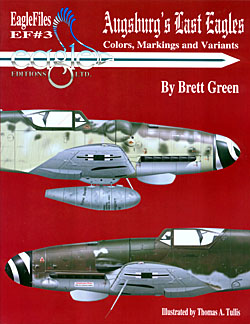 Augsburg's Last Eagles Augsburg's Last Eagles
Colors, Markings, and Variants
EagleFiles EF #3
By Brett Green
Eagle Editions LTD, ©2000
80 Pages, Softbound
ISBN 0-9660706-5-8
MSRP $30.00 USD The Messerschmitt Bf 109 is one of my favorite planes and lately I have been blessed by several new titles on this plane. This is one of the recent titles to come across my desk and a quick glance shows it to be a well-planned title, with an even balance between text, photos, and color profiles. The book starts with a discussion on RLM colors in general, and how the Bf 109 was camouflaged up until the introduction of the late-war colors in 1944. Pretty much from 1941 to 1944 all the Bf 109s were finished at the factory in a two-tone gray upper and a light blue-gray lower camouflage, with mottling of several colors on the fuselage sides (well, except for those going to Africa, of course). Sometime in the middle of 1944 the new "late-war" colors of RLM 81, 82 and 83 were introduced, replacing 70, 71 and 74. The text mentions that these replacements weren't always seen, but doesn't mention that the same order outlining the replacements also stated that the factories needed to use up their surplus 70, 71 and 74 batches before switching to the new colors. Since the factories building bombers and transports had large stocks of 70 and 71, these colors remained on those types right up through the end of the war. The high rate of attrition in the fighter force, though, quickly led to the adoption of the new colors as the old stocks were depleted. After introducing the new colors, the book moves on to talk about variations such as the overall RLM 76 fighters used for night fighting. Another section talks about markings and Reich Defense bands. The rest of the book talks about the last remaining Bf 109 in its original paint, the Bf 109G-6 in Australia. This section is filled with color photographs of the plane as well as a written outline of what the colors are supposed to be. One of the interesting features of this particular Bf 109 is that it has the odd "yellow-green" color on the fuselage sides. This is described in the text as being a light overspraying of a yellow-green paint (similar to the RAF's Sky) over the existing base of RLM 76. This does go a great distance towards proving that there was a yellow-green color found in the late-war years, but they don't identify it with any RLM number. Overall the books provides a good glimpse of the Australian Bf 109 with photos that are unlikely to be found elsewhere. The rest of the information can be found elsewhere, though, and if you're looking for an in-depth discussion on late war colors you'd probably be better served by the JaPo book on the Bf 109K (reviewed here). However if you want a book filled with some nice photos of late war 109s, this will be a welcome addition to your library. | 


 



 |